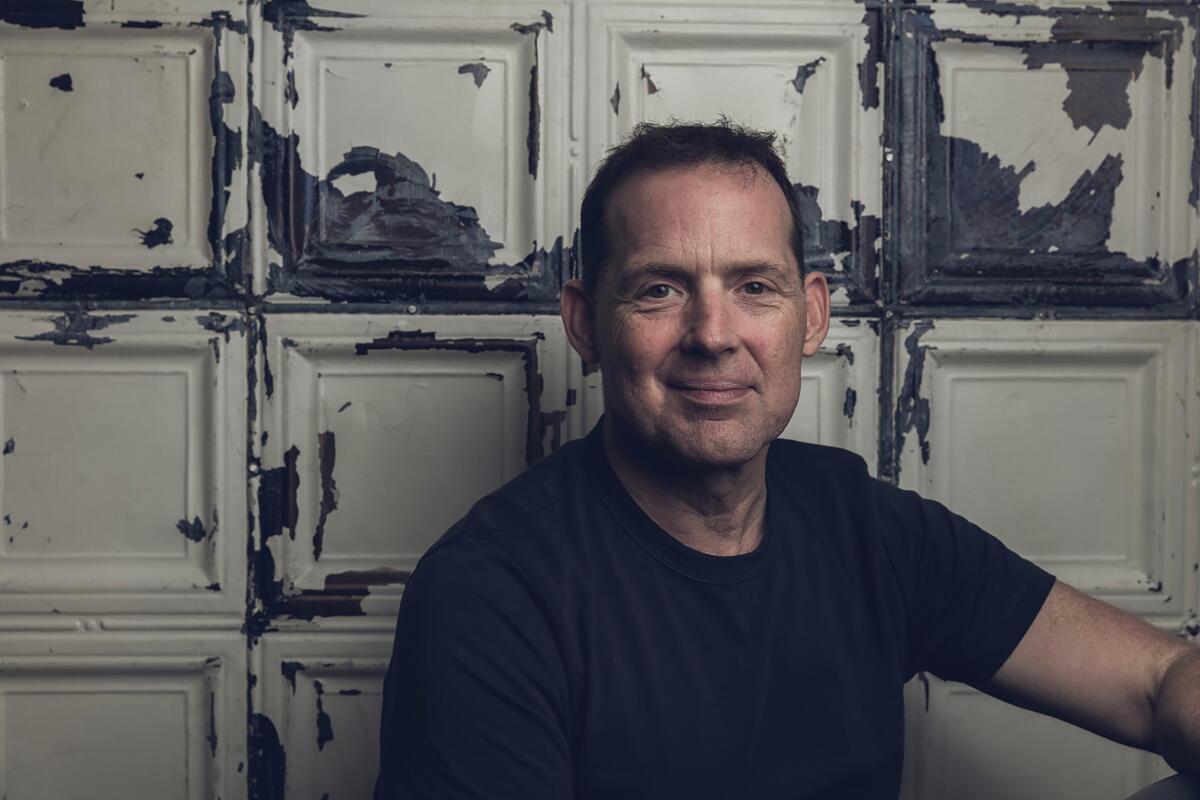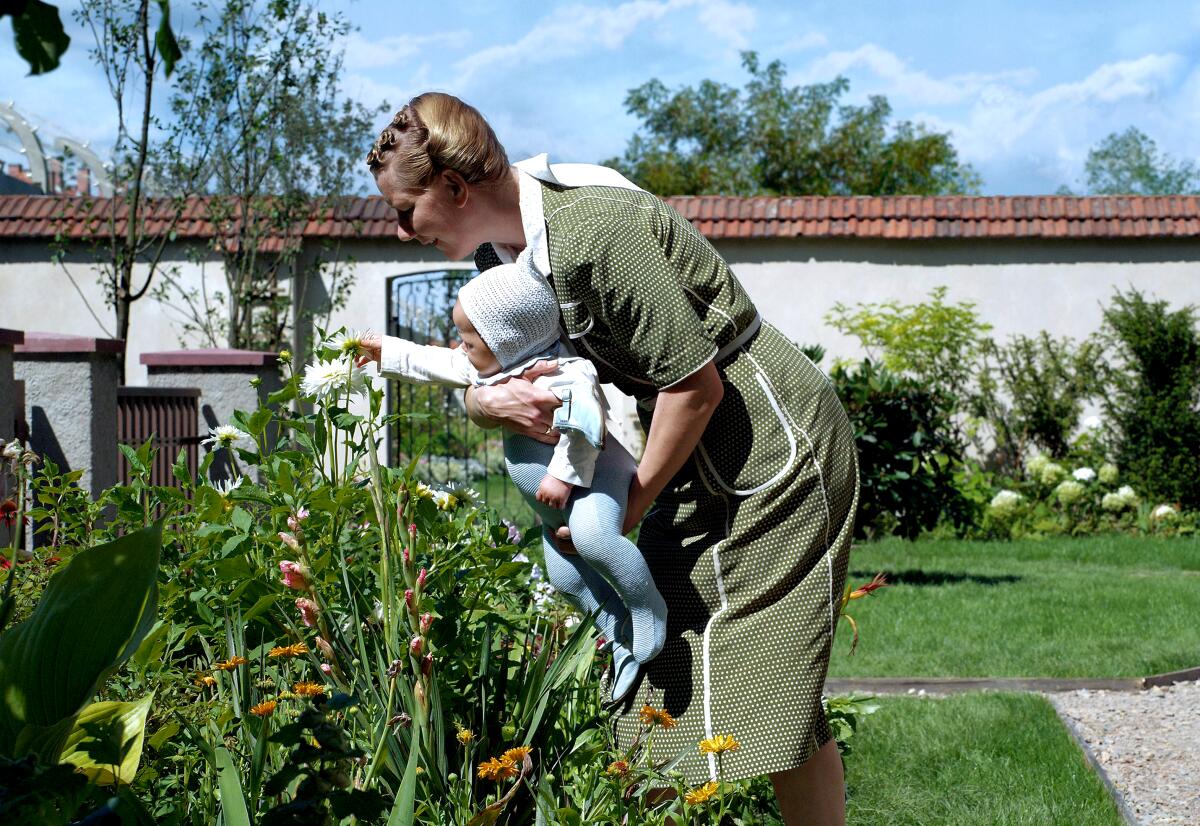Subtle moments of sound add to the chilling impact of ‘Zone of Interest’

- Share via
When British sound designer Johnnie Burn first started working with countryman Jonathan Glazer — on the director’s “Under the Skin,” also Burn’s first film job after years in music videos (and creating the signature burbling Skype ringtone) — he sensed a kindred spirit about the immersive, molecular level at which sound can operate.
“For so many directors, sound is a supporting role to create the suspension of disbelief,” Burn said recently via Zoom from his home base in Brighton. “But Jonathan understands sound is 50% of the experience, and it has enormous power to turn the emotion or narrative.”
That ethos became years of work on “The Zone of Interest,” Glazer’s chilling depiction of the everyday world of an ambitious Auschwitz commandant and his upper-middle-class family living right outside the death camp’s perimeter in a well-manicured suburban serenity at willful odds with the horror yards away. As in, the horror anyone would hear if they chose to hear it: artillery, marching, the omnipresent industrial rumble of a genocidal apparatus. Rudolf Höss and his wife, Hedwig, however, can laugh in their bedroom about taking a European vacation and not react to gunshots or screams in the distance.
“Jon realized he could never put an image in your head that was as powerful as the one you could make on your own,” says Burn, whose research document of site-and-era-specific sounds ran to 600 pages. “So you sit there, with our collective knowledge of what happened, and every single sound, no matter how loud it is, is extremely violent. The sound works as constant reinforcement of the whole premise of the film.” When the film premiered to raves at Cannes, what Burn achieved was so admired that he won the festival’s prestigious technical artistry award.
On “Zone,” for which Burn had his largest-ever sound budget, two distinct audioscapes were required: a banal foreground and the grim background. On the house-and-garden set in Poland, 20 hidden directional microphones captured the real sounds of the actors simultaneously performing in long takes across many rooms and spaces — “Nazis in the Big Brother house” was Glazer’s quip for his deliberately emotionless, multicamera aesthetic. Footsteps, talking, teacups rattling, children playing, nature outside. “That was the first process, to edit that together and make sure there was continuity,” says Burn.
That paradoxically “very pleasant” audio mix of a household — “the odd chirping bird, nothing awful,” notes Burn — would then be augmented over many more months with the hellish reality nearby. He points to a scene where Hedwig and her visiting mother take a stroll through the beautifully landscaped grounds that abut one of the camp’s walls. “Jon would say, ‘Let’s hear 20 prisoners being marched by a guard who is shouting,’ and I would go to my database of thousands, and in Poland we had a Foley team who grouped together 50 people. We had wooden clogs, bare feet, walking on gravel, walking on grass. That’s one layer.”

Then came the guards yelling, recordings that Burn monitored for overacting. “Anything that was hammy would stick out like a sore thumb.” A day spent capturing guns from the period was another opportunity for historical accuracy. “The weaponry they had at Auschwitz was not the stuff on the front line. It was from the First World War. So we had the correct arsenal of sound for that.”
Burn’s commitment to sound as its own omnipresent narrative led to another addition based on his research. “In order to protect the guards’ sanity, they would start a motorbike or two and rev that up to drown out the screams of the murdered,” he says. “Hence the reason for that sound.” All in all, just the garden scene alone ultimately used over 500 different incidences of sound. It was the kind of work impossible not to get depressed about. Burn adds, “Jonathan and I had dark moments, not feeling good about a scene really working.”
Burn also operated in tandem with composer Mica Levi, whose music can feel like soundscapes too. One of the revelations the filmmakers had was that a score over scenes didn’t play well. “Then Mica had an idea that it could work as an overture, and it’s extraordinary,” Burn says of Levi’s opening groan of a composition, heard before we see anything. “The other thing it does is say, ‘Use your ears.’ And that’s very powerful.”
Burn certainly made the most of his ears on “Zone,” his aurally acute energies getting such a workout (postproduction took 20 months) that he feels comfortable quipping, “I’m sort of hoping Jonathan doesn’t make another one for another 10 years.” He laughs out loud after voicing it, but the reality — apart from how infrequently Glazer actually does make films — is that his work for Glazer has ensured he’s the sought-after sound designer for auteurs seeking precise environments, having now been that for Yorgos Lanthimos (“Poor Things”) and Jordan Peele (“Nope”).
Asked what further insight into sound he got from his time on “Zone,” Burn doesn’t hesitate. “Immersive cinema is about sound you can believe in,” he says. “More so than sound that’s loud, that flies around your head. The credibility in the sound you use is more important.”
More to Read
From the Oscars to the Emmys.
Get the Envelope newsletter for exclusive awards season coverage, behind-the-scenes stories from the Envelope podcast and columnist Glenn Whipp’s must-read analysis.
You may occasionally receive promotional content from the Los Angeles Times.










